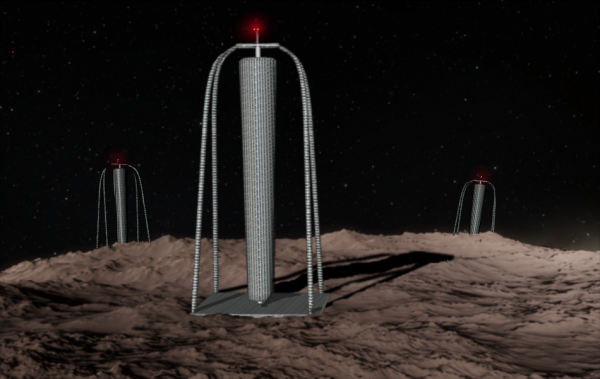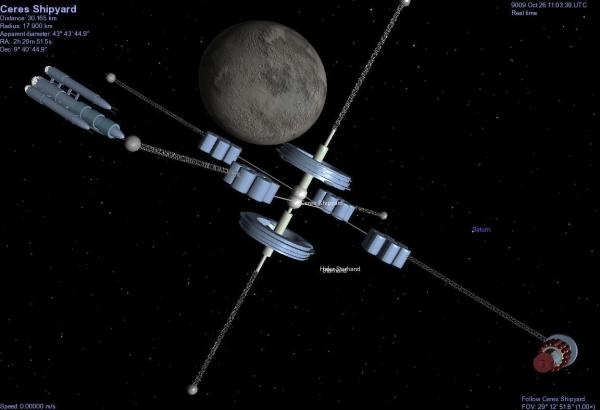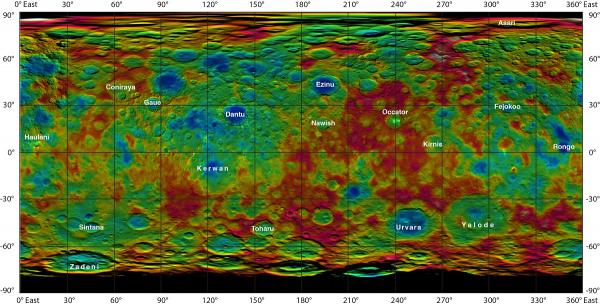BY LETTER
Ceres - The Early Years
History > 0030 to 0900 AT: Solsys Era
History > Significant Historical Events
Galactography > Other Major Polities, Empires, and Meta-Empires > Solsys Organization
History > Significant Historical Events
Galactography > Other Major Polities, Empires, and Meta-Empires > Solsys Organization
 Image from Steve Bowers | |
| Conical rotating habitats on the surface of Ceres during the Interplanetary Age; these structures provided a comfortable habitat for visitors who could not tolerate extended periods in low gravity | |
The first Manned landing on Ceres was in 2101 c.e. (132 A.T.) in Kerwan Crater, when three beam-accelerated NASA/Russian space programme craft arrived to establish a base and small scale mining operation. When the crew returned to Earth three years later an autonomous mining operation had been established, controlled by a near-sophont AI known as Anya.
This operation was successful in producing return fuel for the next several missions, until a permanent manned base was set up at Kerwan Landing in 2140 c.e. (171 A.T.). Similar return fuel operations were being established on other asteroids, many of them privately financed, and in this way the commercialization of the Asteroid Belt began.
By 2160 c.e. (191 A.T.) there were dozens of independent mining companies sending craft to the Belt, each relying on the return fuel mining operations to get back to Earth orbit with their cargo of metals. The Dzougatov Mining Company and the SkyMining Corporation both had mines on Ceres, a small Chinese space habitat was in orbit around the planetoid, and the facility at Kerwan was now under joint NARESA (North American/Russian/European Space Authority) control.
Due to the constant disputes over territory on Ceres and the other asteroid colonies the United Nations of Earth sent a joint mission to link up with the four small colonies on Ceres and establish an administrative centre for the entire asteroid belt. An underground town was quickly constructed in a deep Dzougatov strip mine in Dantu crater, and in 2169 (201 AT) Ceres City was pressurised, ready to attempt regulation of the already chaotic minor planets and their inhabitants.
By 215 AT Ares heavy Lifting and Lee Interorbital had commenced Spacecraft construction in the Ceres Shipyards, actually two widely separated swarms of manufactory elements in orbit 2000 km from Ceres; the establishment of an independent utopian Jene colony in an old Skymine excavation brought idealists from Earth to increase Ceres' population; and the independent Belters established Occator Freeport, located near the famous Ceres White Spot.
Freeport was later to become a haven for organised crime, underground political movements and bizarre entertainment, at first suppressed by Ceres city police until the 2228 Freeport Unilateral Declaration of Autonomy.
 Image from Steve Bowers | |
| Ceres Shipyard | |
Related Articles
Appears in Topics
Development Notes
Text by Steve Bowers
Graphics by Steve Bowers made with Celestia
Initially published on 05 November 2003.
Map from the NASA Dawn mission; full details and acknowledgements here
Dawn mission
Graphics by Steve Bowers made with Celestia
Initially published on 05 November 2003.
Map from the NASA Dawn mission; full details and acknowledgements here
Dawn mission







